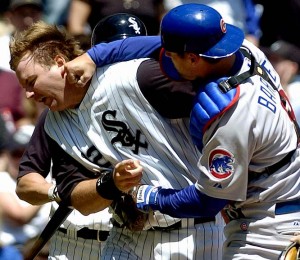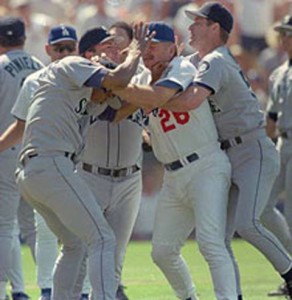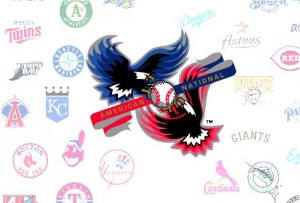Another year of Interleague baseball (and an American League victory) is in the books, and unfortunately for the haters, it was deemed a success by Major League Baseball. Commissioner Bud Selig’s brainchild surely won’t be going anywhere anytime soon.
By Jake McCormick
If you ask the average baseball fan their opinion on Interleague Play, odds are they will either go on a rant about ruining something that makes baseball unique (league segregation) or have a fairly indifferent attitude towards it. Very rarely will you hear someone glowingly describe their favorite Pittsburgh Pirates/Boston Red Sox game.
Despite the general attitude of negativity and/or indifference, Interleague baseball has proven to be a financial success for the MLB, and thus will become a fixture for years to come. Consider a recent MLB.com article:
“Interleague Play 2010 drew 8,379,834 fans for an average of 33,253 per game. That’s 17.8 percent higher than this season’s current intraleague average of 28,233 per game.
Amid ongoing discussion about the future of Interleague Play, the fact remains that crowd numbers soar during this stretch. Since its inception in 1997, Interleague Play has drawn 12 percent more fans than intraleague games. Interleague Play has averaged 33,261 fans per game, compared with the intraleague average of 29,711 fans per game during the same span.”
For the record, I would change Interleague Play so teams would only play their “rival,” because those really are the games that bring the most fans through the turn-styles and it’s a healthy compromise between the detractors and supporters. But just for the sake of playing Devil’s Advocate, I’ve done some “method writing” as Commissioner Selig in a point-counterpoint using the cons listed on an online petition.

On the contrary, it allows teams to revisit unique World Series matchups not seen since the golden age of radio. For example, in 2004, the San Francisco Giants and Boston Red Sox met for the first time in 92 years, and the New York Yankees and Los Angeles Dodgers faced off for the first time since the 1981 World Series. Interleague play also guarantees series that most likely will never beat the odds of making the World Series (Giants vs. Athletics, Reds vs. Indians, Cubs vs. White Sox, Brewers vs. Twins, and so on).
2. The schedule is too unbalanced. The accent on divisional play, combined with Interleague Play, means that teams rarely play certain other teams within their own league.
A total of 5% of games each year are Interleague games, which is a far less percentage than in every other major American sport. Having 15-18 Interleague games before the All-Star Break give teams more than enough time to recover for a playoff run against their intraleague opponents. Schedules are naturally unbalanced in the first place, as teams rotate their number of games against a division on an annual basis, and parity isn’t guaranteed year-to-year in any division.
3. The so-called natural rivalries are contrived. Team rivalries in baseball have always been intraleague, and have developed naturally over decades.
The only true natural rivalry that existed before Interleague play began in 1997 was between the Minnesota Twins and Milwaukee Brewers, and it’s easily one of the best and most heated because of that past tradition.
Sure all the other current rivalries are created, but who doesn’t like rivalries? From the day you step foot into high school to your first MLB game, there is always an arch nemesis that elevates the bragging rights, general interest, and most importantly, ticket sales. Every rivalry started somewhere, and in 50 years the annual Cubs/White Sox Crosstown Cup will be just a notch or two below Cubs/Cardinals.

Again, this is a common occurrence in intraleague play. Teams run hot and cold on a regular basis in baseball, and it’s all a matter of when you are scheduled to play them. Is it fair if the Angels get swept by the red-hot Tampa Bay Rays in May, and the Texas Rangers sweep a cooled off Rays team in June? No, but that’s baseball, and the outcome of a pennant race is going to ultimately be decided in the last two months of the season, not the first three.
5. The two leagues have different rules. When American League teams play in National League parks (during Interleague), they are not allowed to use a designated hitter as they normally do. Not being able to field their regular lineups puts AL teams at a disadvantage.
Yet the American League has not lost the overall Interleague battle since 2003, and have won more games than the National League in 10 of the 14 years Interleague Play has been around. Interleague also gives fans the chance to see Albert Pujols face off against CC Sabathia or Tim Lincecum thrown down with Joe Mauer.
Watching pitchers that have never swung a bat at the Major League level is always funny (with respect to rare mishaps like that of Chien-Ming Wang), and it also allows the more strategy-interested fan the opportunity to watch the AL team adjust to NL rules, and vice versa.
These are basic points you would hear in an argument about the pros and cons of Interleague Play, so go ahead and debate with yourself over which side is correct. Just remember that baseball is a business first and foremost, and money often will outweigh tradition if they are facing off head-to-head.
